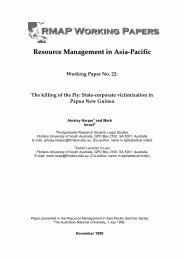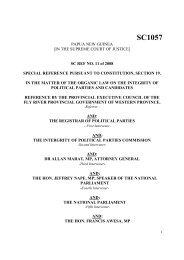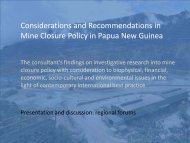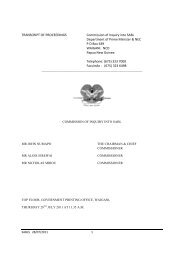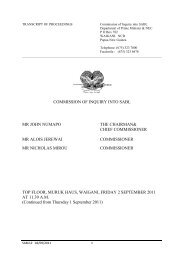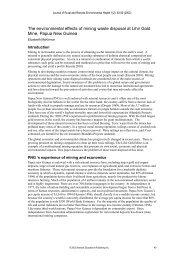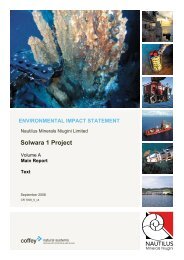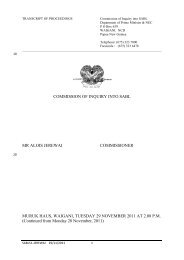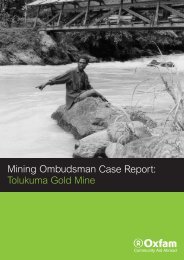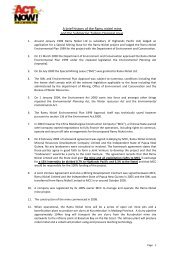Fishy business. The Social Impact of SST.pdf - Act Now!
Fishy business. The Social Impact of SST.pdf - Act Now!
Fishy business. The Social Impact of SST.pdf - Act Now!
You also want an ePaper? Increase the reach of your titles
YUMPU automatically turns print PDFs into web optimized ePapers that Google loves.
Finally, Honourable Ministers, Members <strong>of</strong> Parliament and the Provincial Assembly, memberfriends <strong>of</strong> PNA, the Director <strong>of</strong> FFA, Shareholders, Directors, management and staff <strong>of</strong> theSouthseas Tuna Corporation, distinguished guests and people <strong>of</strong> East Sepik, it gives me greatpleasure to now declare the Wewak Tuna Loining Plant Open! (<strong>The</strong> Official Website <strong>of</strong> thePrime Minister <strong>of</strong> Papua New Guinea)______________________________________________________________________6. Workplace HazardsOccupational Hazards Online Magazine January 2002, pp111-113:Work speed and potential health impactWomen reported more <strong>of</strong>ten than men that their jobs were uninteresting, that they could notmove around, and that their work speed was fast. <strong>The</strong>y also reported doing more night andweekend shifts (possibly for economic reasons). All job categories entailed lifting. Womenreported feelings <strong>of</strong> fatigue and stress, and tired hands, feet, back and legs more <strong>of</strong>ten than men,as well as greater insomnia, more aches and pains, digestive problems, and headaches. Taken inconjunction with their reports <strong>of</strong> more uncomfortable environments and more unpleasantworking conditions than men, the question therefore arises as to whether these health problemsare related to the sex difference itself, to differences in reporting between the two sexes, or todifferences in working conditions. Work speed in relation to the health variables was thereforeexamined, for two reasons. Firstly, in a large study <strong>of</strong> poultry slaughterhouse workers, womenreported a significantly higher work speed than men. Secondly, other workers' reports seemed toindicate fast work speed as a relatively constant characteristic <strong>of</strong> women's factory and hospitaljobs. In the fish factory, fast work speed was found to be associated with fatigue, stress,insomnia, and digestive problems in both sexes, and with aches and pains in women. Clearly,the methodology used rest ricted analysis to workers' own perceptions <strong>of</strong> their health problems.But it did reveal some additional data not perceptible through routine measurements. Ameasurement <strong>of</strong> temperature alone, for example, cannot determine the influence <strong>of</strong> workerimmobility, degree <strong>of</strong> humidity, or whether adequate protective clothing is worn. Similarly,physical medical examinations may not detect the role <strong>of</strong> symptoms such as stress, insomnia,and random aches and pains, and the beginnings <strong>of</strong> acute conditions with a long latency period.This analysis therefore related perceived environmental variables to perceived health effects.Workers reporting a specific problem in their micro-environment tended to report the samehealth effect, which suggested that such a correlation actually existed. <strong>The</strong> best control,however, for a cause and effect association between an environmental hazard and a health effectis the removal or attenuation <strong>of</strong> the hazard, with consequent verification <strong>of</strong> the health effect.It remains to be explained why women in the fish-processing and poultry slaughtering industriesmanifested higher health risk factors in relation to fast work speed. <strong>The</strong> traditional explanations<strong>of</strong> less tolerance in women are unsatisfactory. <strong>The</strong> authors suggest that women's factory work<strong>of</strong>ten requires them to work at a faster and more constant rate than men, even if men describetheir work speed as fast. Women also do housework and undertake childcare, which may have asynergistic effect on the health symptoms reported through factory work. All women's tasksneed to be taken into account in estimating occupational health risk.199



